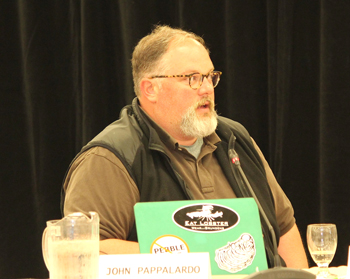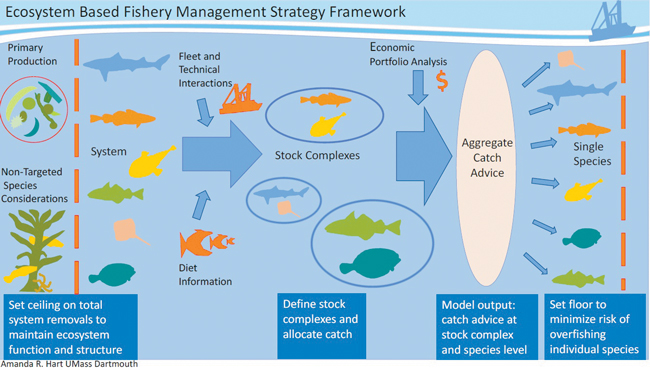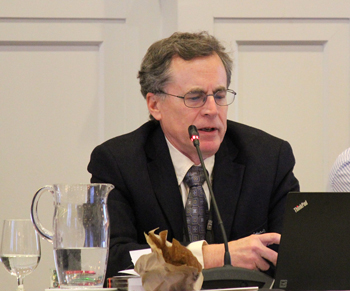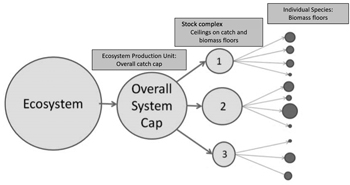Ecosystem-based Fisheries Management
A highly complex task
by Laurie Schreiber

“The harvest control rules will be driven differently than the single species approach. Everything’s going to be turned upside-down and we’ll essentially dump everything on the floor and rebuild under this concept.” – John Pappalardo, chairman, NRFMC.
GLOUCESTER, Mass. – At its September meeting, the New England Fishery Management Council (NEFMC) grappled with the complexities of ecosystem-based fishery management.
John Pappalardo, chairman of NEFMC’s Ecosystem-Based Fishery Manament (EBFM) committee, presented a completed draft plan that the committee has been working on since 2015.
“It’s been one of the more difficult tasks I’ve been asked to do here at the council,” Pappalardo said.
The task, he continued, involves thinking about how to manage a large area – in this case Georges Bank – as opposed to tweaking individual fishery management plans.
“Ultimately, these discussions were about not whether or not to do this but how to do this,” said Matthew McKenzie, NEFMC member and vice chair of the EBFM Committee. “We have a novel tool but we’re not masters of it. We’ve got a new approach to this entire ecosystem. This is something we need to learn how to do….We’re looking at the details of how we’re going to go down this road in specific ways.”
The committee has
been working to
develop an “example
fishery ecosystem
plan” (eFEP)
for Georges Bank.
The committee has been working to develop an “example fishery ecosystem plan” (eFEP) for Georges Bank. The eFEP will address four issues, according to a NEMFC press release. They are:
• Strategies for deriving catch advice for stock complexes and allocations to fishery functional groups, with a “fishery functional group” being defined as “a group of species that typically are caught together in a particular type of gear and feed on similar food items;”
• Management options for dealing with an overfished stock that is part of a stock complex;
• Spatial management strategies and ecosystem research to conserve habitat, spawning, and protected species in an ecosystem plan; and
• Permitting and allocation strategies that would be consistent with a Fishery Ecosystem Plan.
In his presentation to NEFMC, EBFM Plan Coordinator Andrew Applegate said the eFEP is based on “energy flow” as a fundamental property of an ecosystem.
Energy flow, he said, looks at factors such as primary production, predator/prey relationships, and fishery interactions. It also takes into account climate change as a factor that will persist as an ongoing challenge.

This graphic depicts the complexity of Ecosystem-Based Fishery Management. Graphic courtesy of New England Fishery Management Council. Graphic by Amanda R. Hart, UMass Dartmouth.
“Ecosystem-based fishery management” is a systematic approach to fisheries management in a geographically specified area that contributes to the resilience and sustainability of the ecosystem; recognizes the physical, biological, economic, and social interactions among the fishery-related components of the ecosystem, including humans; and seeks to optimize benefits among a diverse set of societal goals, according to Applegate’s presentation.
Overall, it seeks to integrate a broad spectrum of scientific and management issues, including climate, human dimensions, habitat, forage base, risk policy, and protected species.
Applegate said there are several approaches to crafting an eFEP. It could be developed incrementally, working within the existing fishery management plan structure and adding linkages between plans and the effects of environmental components. It can take a holistic or “revolutionary” approach that adopts integrated analytical framework based on new tools. Or it can be a blend of the two.
EBFM seeks to integrate
a broad spectrum of
scientific and management
issues, including climate,
human dimensions, habitat,
forage base, risk policy,
and protected species.
“The council decided to focus on the holistic, revolutionary approach,” said Applegate.
The planning process was broken into five phases. The first phase was NEFMC’s decision to commission an eFEP for Georges Bank. The process is now in Phase II, the development of an eFEP.
Phase III will involve testing management strategies. Phase IV will develop alternatives for a final FEP. Phase V will involve implementing the FEP and making adjustments.
The plan includes defining species complexes, which are “groups of species that have similar life history characteristics and play similar roles in the transfer of energy in the system.”
Under the Magnuson Stevens Act, said Applegate, stocks may be grouped into complexes if they can’t be targeted independently of one another in a multispecies fishery, if there are insufficient data to determine their status relative to established criteria, or if it’s unfeasible for fishermen to distinguish between individual stocks.
The eFEP will be tested through simulation, said Applegate.
The framework for EBFM is expected to manage fisheries in a way that is more adaptive to changes in the ecosystem and more flexible for fishermen, allowing them to make choices about where and how to fish. It’s expected the plan will allow vessels to land a suite of species in a stock complex. Catch limits within the framework are expected to improve the ecosystem.

“A point that makes me nervous is that nobody in the industry is paying attention.” – Tom Nies, NEFMC Executive Director.
The plan, said Applegate, must also account for things like bycatch, interactions with species that don’t fall under any particular plan, and oversight of some species by other state and federal entities and laws, such as the Atlantic States Marine Fisheries Commission, the Northeast Regional Ocean Council, and the Endangered Species Act.
Georges Bank was chosen for an example fishery ecosystem plan because of existing science and modeling that has been conducted there.
NEFMC member David Pierce wanted to know to what extent a “choke” species like Gulf of Maine cod impacts ecosystem management.
“Right now the stock controlling everything is Gulf of Maine cod,” Pierce said. “You envision, with catch advice for a stock complex, that we might end up with an overall aggregate catch for the Gulf of Maine, but that catch wouldn’t be permissible because we’d set a limit for Gulf of Maine cod that would be a floor. Does that approach then mean that the entire Gulf of Maine shuts down” under the EBFM concept?
“That’s the crux of the question,” replied Applegate. “There’s no single silver bullet. Switching to EBFM isn’t going to alleviate issues of certain species being choke stocks.”
“The plan will allow
vessels to land a
suite of species in
a stock complex.”
– Andrew Applegate,
EBFM Plan Coordinator,
NEFMC
One of the aspects of switching to EBFM, Applegate said, is to provide more management flexibility that would ideally account for nuances around choke stocks. But, he added, “in this case, the stock is quite depleted and therefore it would constrain catch of some other species, but hopefully not all other species. So hopefully it wouldn’t define the total catch for all of the Gulf of Maine.”
He added, “Overall, if we’re developing robust harvest strategies, we might not be in that situation as frequently as we are now.”
NEFMC Executive Director Tom Nies pursued a similar line of questioning.
“So the answer her is, we do ecosystem based management, and then if a stock is depleted we go to single species management?” asked Nies. “We already know that we’ve got stocks that are depleted, at least by current definition…. It sounds a lot like single species management.”
“You’re right in many ways,” replied Applegate. “But in another way, consider it more of a hybrid system. Levels might be based on ecosystem characteristics, or could be carved out through similar measures that we do now for single stocks. This plan doesn’t resolve the potential for becoming a choke stock. It doesn’t relieve the responsibility for taking action to rebuild a stock. What I struggle with is, What’s the appropriate level to rebuild it to within the ecosystem?”
“Getting into the details with where we are now with a number of groundfish stocks, it’s difficult for me to understand how we get out of the box with EBFM without using the same tools we use now,” responded Nies. “I haven’t heard anything about using different tools. I haven’t seen development of what these different tools are that are going to resolve this.”

Stock complex harvest control rules will be considered under the example Fishery Ecosystem Plan for Georges Bank. Graphic courtesy of New England Fishery Management Council.
“The tools are similar, but the application is somewhat different,” replied Applegate. “We haven’t evaluated strategies for dealing with that yet.”
What’s potentially different about EBFM, explained Applegate, is that harvest control strategies can be implemented to reduce catch on either a stock complex or an individual stock within a stock complex.
“The harvest control rules will be driven differently than the single species approach,” said Pappalardo. “Everything’s going to be turned upside-down and we’ll essentially dump everything on the floor and rebuild under this concept. We don’t know if the triggers or the floors are the same, under this approach, as they are under single species management.”
“This is a really good discussion because it’s getting to the crux of how people understand how we might implement ecosystem based fisheries management,” George Lapointe, who addressed NEFMC as a representative of Fisheries Survival Fund and Blue Harvest Fisheries. “The concern I’ve expressed before and still express is that the PDT has done a great job, but you have these suites of different options on each level….You can’t draw a picture of what this looks like and how it might impact people, other than we’re throwing everything on the floor and we want to rebuild it. That’s not a satisfying standard.”
McKenzie said the committee will need council guidance on next steps for how to operationalize the plan.
“That’s where we need to grapple with legal, scientific, and management realities,” he said.
“A point that makes me nervous is that nobody in the industry is paying attention,” said Nies. “That’s perhaps an exaggeration, but there’s not been a lot of widespread participation by the industry” and other stakeholders.
“At no point did the steering committee ever think we would not consult with stakeholders,” responded McKenzie. “We focused on what we want out of this effort befpre taking it to stakeholders. Once we have that, then of course we’ll go to stakeholders and reiterate as we gain input.”
For now, McKenzie said, it’s about how to take a conceptual document and turn it into management alternatives.
